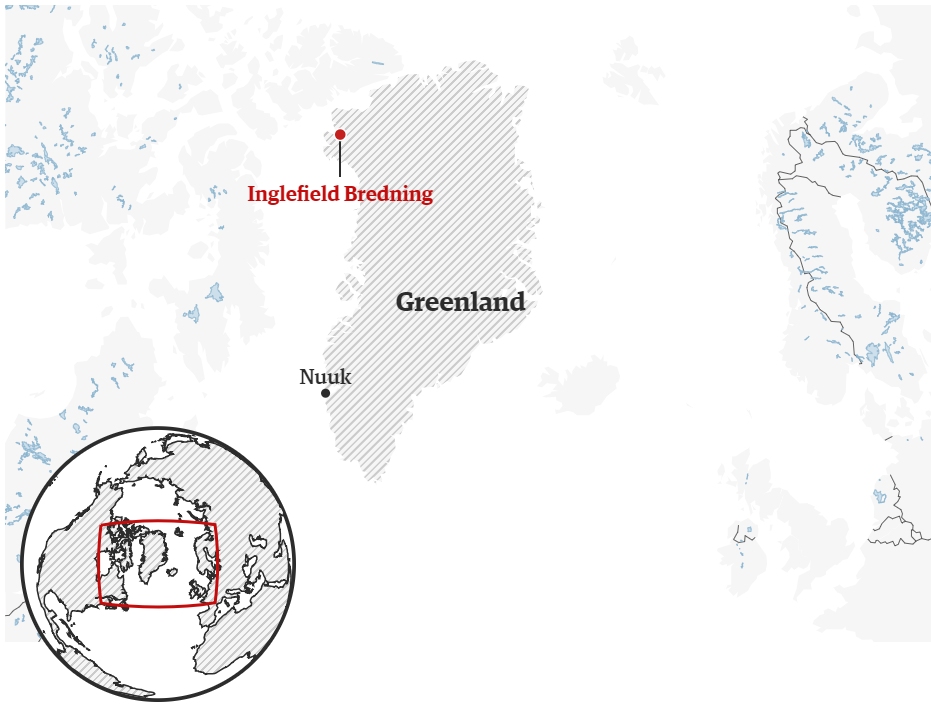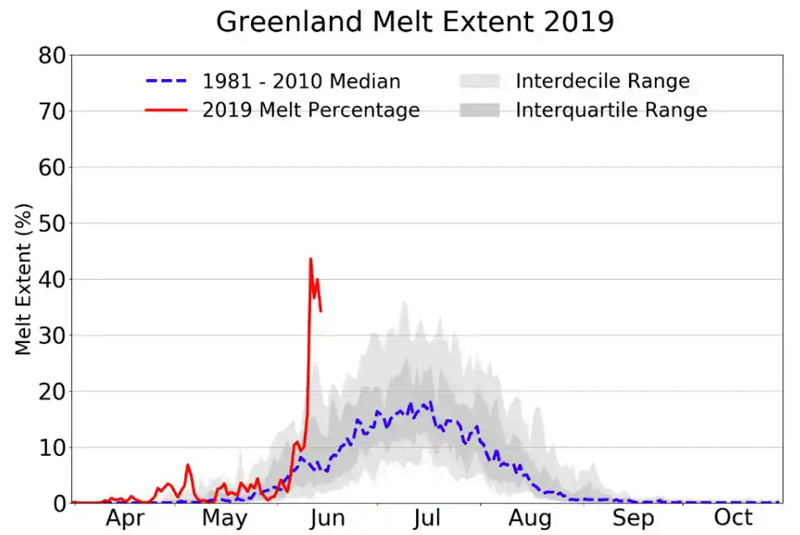
STOCKHOLM, Sweden (AFP) — As Europe’s record-breaking heatwave drifts towards the Arctic it threatens to accelerate the melting of ice in Greenland, which already started earlier than normal this year, climate scientists warned Saturday.
After breaking records over Europe, the heatwave has swept over Scandinavia and is predicted to move towards Greenland, according to the World Meteorological Organisation.
Saturn and Ketu are conjunct in a fire sign – and remain so – until the end of this year (and early 2020). What does this augur for Climate Change?

The Planets
Saturn (21°47′) conjunct Ketu (22°25′) in Sagittarius, a fire sign. Kuja vat Ketu rule applies, indicating Ketu will behave like Mars and deliver an environment of fire and heat; there is also the enmity of Mars and Saturn which is also reproduced in a Ketu-Saturn conjunction. There is heat in the kitchen. Water is needed to cool things down, and as all this is occurring in Purva Ashada nakshatra, we look to the goddess of Purva Ashada, Apas, the goddess of water. This conjunction will remain in place in Sagittarius for the remainder of the year. At this point in time we have four planets in the water sign Cancer – Sun, Mars, Mercury and Venus, two of which are the fire element, Sun and Mars.
Mercury takes the nature of the planets it is with, so we may say, three planets are melting the waters of Cancer; so the melting of the Greenland ice sheet is a reality. Things will continue to heat up on our planet, and we need to look to the warnings about biodiversity and life in water, as recently issued by the United Nations. Saturn is duty, task, responsibility – so here we have Saturn issuing a challenge to every nation, every continent, and those coalitions and bodies responsible for transformations and the future. Take heed, matters will heat up, and life is at risk, particularly, life in water.
The following is from the UN Biodiversity Report issued 6 May 2019, and alerts us to challenges to species and life forms. Note the risks for species what live in water:

Saturn is the driver warning us of melting ice-caps, sea-level rise, warming of the oceans and other water-related environmental issues. Ketu (normally scattered, unconcerned) v. Saturn is expressing the need for those who take no responsibility for the climate to become painfully aware of the need to make an effort.
We mentioned before that there are four planets in Cancer. In mundane astrology, Cancer signifies coastal areas, mangroves, sea grasses, tidal marshes, carbon losses and coastal ecosystem management. Cancer also oversights terrestrial and freshwater ecosystems and their services, such as rivarine flows, estuaries, locks, dams, and ponds. Taking a deeper examination in Cancer, we find Cancer (water sign) holds future global climate news with scenario based projections and near-term information. We take the near term information as the melting ice sheet of Greenland.

A photo, taken by Steffen Olsen from the Centre for Ocean and Ice at the Danish Meteorological Institute on 13 June, showed sled dogs wading through water ankle-deep on top of a melting ice sheet in the country’s north-west. In the startling image, it seems as though the dogs are walking on water.
The photo, taken in the Inglefield Bredning fjord, depicted water on top of what Olsen said was an ice sheet 1.2 metres thick.
His colleague at the institute, Rasmus Tonboe, tweeted that the “rapid melt and sea ice with low permeability and few cracks leaves the melt water on top“.

Olsen tweeted that his team relied on traditional knowledge from local hunters and their dogs as they searched for dry spots on the ice. The team also used satellite images to plan their trip. He said the photos documented an “unusual day” and that the image was “more symbolic than scientific to many”.
Ruth Mottram, climate scientist at the Danish Meteorological Institute, told the Guardian: “This year the expedition to retrieve the instruments – by dog-sled, still the most practical way to get around in this region at this time of year – ran into a lot of standing water on the sea ice. The ice here forms pretty reliably every winter and is very thick, which means that there are relatively few fractures for meltwater to drain through. Last week saw the onset of very warm conditions in Greenland and in fact much of the rest of the Arctic, driven by warmer air moving up from the south.”
She said these conditions had let to “a lot of melting ice, on the glaciers and ice sheet, and on the still-existing sea ice”. The DMI weather station nearby at Qaanaaq airport registered a high of 17.3C last Wednesday and 15C last Thursday, which is high for northern Greenland, even in summer. Mottram cautioned that the numbers were provisional and would be subject to checking.
In other areas, meltwater drains away through fractures in the ice to the rocks far below, and so does not leave standing water on the surface. But because the ice in the region is thick and fracture-free, the water pools above the ice, giving rise to the dramatic photograph.
Melting events such as the one pictured would normally not happen until later in the summer, in late June or July. Mottram said it was too soon to say what role global warming had played, because although these temperatures were unusual, the conditions were not unprecedented and “still a weather-driven extreme event, so it’s hard to pin it down to climate change alone”.
In general, however, she said: “Our climate model simulations expect there to be a general decline in the length of the sea ice season around Greenland, [but] how fast and how much is very much dependent on how much global temperature rises.”
She said forecasts indicated that the warm conditions over Greenland would persist at least for another few days, so the dog-sled teams will face further tough going.

The photograph emerged amid concerning temperature data from Greenland. On Saturday, the Washington Post’s Capital Weather Gang said weather models showed that temperatures over parts of Greenland peaked at 4.4C (40F) above normal last Wednesday, the day before the photo was taken.
Above-average temperatures over nearly all of the Arctic ocean and Greenland during May have led to an early ice retreat, with the second-lowest extent of ice in the 40-year satellite record being registered, according to the US National Snow and Ice Data Centre.
The centre said that Arctic sea ice for May was 12m square kilometres (4.7m square miles), 1.13m square kilometres below the 1981-2010 average.
Air temperatures at the end of May along the western Greenland coast were as much as 7C (13F) above the 1981-2010 reference average for the month, the centre said. It also recorded Arctic ocean temperatures of 2-4C above the average.
“The melting is big and early,” Jason Box, an ice climatologist at the Geological Survey of Denmark and Greenland, told the Washington Post.
At a local level, the sea ice melt provides significant problems for communities in Greenland, who rely on it for transport, hunting and fishing.
“Extreme events, here flooding of the ice by abrupt onset of surface melt, call for an increased predictive capacity in the Arctic,” said Olsen.
![]()
